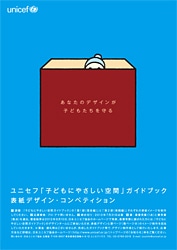



[TOKYO, JAPAN, 14 June 2013]
 |
| © Japan Committee for UNICEF |
| Download the application flyer (1.1 MB) (Entries no longer accepted) |
Natural disasters and armed conflicts around the world frequently and instantaneously rob children of their sense of normality. The Japan Committee for UNICEF (JCU) understands the importance of acting fast so that the emotional wounds suffered by children as a result of these events do not deepen. Securing child friendly spaces, such as school buildings or refugee camps that serve as temporary homes, is vital to ensuring that children have a safe and peaceful place to live and play. All of these elements form what is "normal" for children, and they are an important requirement along with food, drinking water and medical assistance.
In response to the Great East Japan Earthquake of 11 March 2011, JCU and many other assistance providers worked to provide child friendly spaces for children living in refuge.
One specialist implementing psychosocial assistance on the front lines in Japan noted that, "Japan is victim to frequent natural disasters, including typhoons and earthquakes, and that is why emergency assistance that includes establishing child friendly spaces should be the standard." Another specialist added, "What we really need is a practical guidebook that can be used on the ground where assistance is being implemented."
In light of this need, JCU and the National Information Center of Disaster Mental Health have started the production of a Japanese version of UNICEF's "A Practical Guide for Developing Child Friendly Spaces". This guide was published in 2010 as a compilation of 20 years of UNICEF experience developing child-friendly spaces.
The Japanese version of the UNICEF publication "A Practical Guide for Developing Child Friendly Spaces" is scheduled for completion this autumn and will be distributed to the NPO/NGO community, local governments, and the central Japanese Government including the Ministry of Health, Labour and Welfare, as well as mental health and medical specialists.
Now is your chance to use your design skills to contribute to creating a new Japanese standard!
Overview
Rules, How to Apply, etc.
Fill out the Application Form and submit it to the following address by postal mail. Entries are not accepted via email.
Entries must arrive by 31 July 2013.
 |
| © Japan Committee for UNICEF |
 Download the application flyer (1.1 MB) (Entries no longer accepted) Download the application flyer (1.1 MB) (Entries no longer accepted) |
All submissions will be judged by a committed comprised of the following individuals (alphabetical order):Osamu Fukushima (Fukushima Design), Ken Hayami (Executive Director of Japan Committee for UNICEF / Chief, Emergency Assistance Headquarters), Yoshiharu Kin (Director National Information Center of Disaster Mental Health, National Institute of Mental Health), Kazufumi Nagai (Hakuhodo Design), Susumu Namikawa (Dentsu Social Design Engine).
We are looking forward to receiving your entries!
Inquiries
Information and Public Affairs Division, Japan Committee for UNICEF
Phone: 03-5789-2016 Fax: 03-5789-2036
Email:jcuinfo@unicef.or.jp
Click here for more information about JCU's pychosocial assistance in 2013 (Japanese only) »